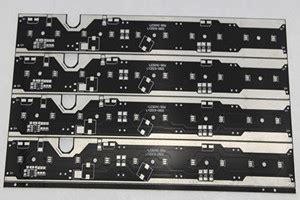What are Aluminum PCBs?
Aluminum PCBs are printed circuit boards that use aluminum as the base material instead of the traditional FR-4 or other materials. The aluminum substrate provides excellent thermal conductivity, which makes these PCBs ideal for applications that require efficient heat dissipation. Aluminum PCBs are widely used in high-power electronics, LED lighting, and other industries where thermal management is critical.
Advantages of Aluminum PCBs
Aluminum PCBs offer several advantages over traditional PCBs:
- Excellent thermal conductivity
- Lightweight and durable
- Cost-effective for high-volume production
- Good electrical insulation
- Suitable for high-power applications
How are Aluminum PCBs Manufactured?
The manufacturing process of aluminum PCBs is similar to that of traditional PCBs, with a few key differences. The process typically involves the following steps:
- Cleaning and surface treatment of the aluminum substrate
- Application of a dielectric layer
- Copper foil lamination
- Photoresist application and exposure
- Etching and plating
- Solder mask application and silkscreen printing
- Surface finish application (e.g., HASL, ENIG, or OSP)
- Cutting and drilling
- Electrical testing and quality control
Dielectric Layer Options
There are several dielectric layer options available for aluminum PCBs, each with its own advantages and disadvantages:
| Dielectric Material | Thermal Conductivity (W/mK) | Dielectric Constant | Dielectric Strength (kV/mm) |
|---|---|---|---|
| Epoxy Resin | 0.2 – 0.3 | 3.5 – 4.5 | 20 – 30 |
| Polyimide | 0.1 – 0.2 | 3.5 – 4.0 | 20 – 30 |
| Ceramic | 2.0 – 30.0 | 5.0 – 10.0 | 10 – 20 |
| Thermal Adhesive | 0.5 – 2.0 | 2.5 – 3.5 | 10 – 20 |

Applications of Aluminum PCBs
Aluminum PCBs are used in a wide range of industries and applications, including:
- LED lighting
- Automotive electronics
- Power electronics
- Telecommunications
- Aerospace and defense
- Medical devices
- Industrial control systems
LED Lighting
Aluminum PCBs are particularly well-suited for LED lighting applications due to their excellent thermal management capabilities. LEDs generate a significant amount of heat, which can reduce their lifespan and efficiency if not properly dissipated. By using aluminum PCBs, LED manufacturers can ensure that the heat is quickly and efficiently conducted away from the LEDs, resulting in longer lifespans and better performance.
Automotive Electronics
In the automotive industry, aluminum PCBs are used in various applications, such as:
- Engine control units (ECUs)
- Power inverters
- Battery management systems
- LED headlights and taillights
The thermal management capabilities of aluminum PCBs help ensure that these critical components operate reliably in the harsh environment of a vehicle.

Design Considerations for Aluminum PCBs
When designing aluminum PCBs, there are several factors to consider:
- Thermal management: Ensure that the layout and component placement optimize heat dissipation.
- Dielectric layer selection: Choose a dielectric layer that balances thermal conductivity, electrical insulation, and cost.
- Copper thickness: Thicker copper layers can improve current carrying capacity and heat dissipation.
- Hole-to-hole spacing: Aluminum PCBs may require larger hole-to-hole spacing compared to traditional PCBs due to the thermal expansion of the aluminum substrate.
- Solder mask and silkscreen: Ensure that the solder mask and silkscreen materials are compatible with the aluminum substrate and can withstand the expected operating temperatures.

Choosing the Right Manufacturer
When selecting a manufacturer for your aluminum PCB project, consider the following factors:
- Experience: Look for a manufacturer with a proven track record of producing high-quality aluminum PCBs.
- Capabilities: Ensure that the manufacturer has the necessary equipment and expertise to meet your specific requirements.
- Quality control: Choose a manufacturer with a robust quality control process to ensure consistent and reliable results.
- Customer support: Look for a manufacturer that provides excellent customer support and is responsive to your needs.
RAYPCB is a leading manufacturer of aluminum PCBs, offering a wide range of services and capabilities to meet the needs of various industries. With state-of-the-art equipment, experienced engineers, and a commitment to quality, RAYPCB is well-positioned to support your aluminum PCB projects.
Frequently Asked Questions (FAQ)
-
Q: What are the benefits of using aluminum PCBs compared to traditional PCBs?
A: Aluminum PCBs offer excellent thermal conductivity, making them ideal for applications that require efficient heat dissipation. They are also lightweight, durable, and cost-effective for high-volume production. -
Q: Can aluminum PCBs be used in high-frequency applications?
A: Yes, aluminum PCBs can be used in high-frequency applications. However, the choice of dielectric layer and the design of the PCB layout must be carefully considered to minimize signal loss and ensure optimal performance. -
Q: Are aluminum PCBs more expensive than traditional PCBs?
A: The cost of aluminum PCBs can be higher than traditional PCBs due to the additional processing steps and materials required. However, for high-volume production and applications that require excellent thermal management, aluminum PCBs can be a cost-effective solution. -
Q: What surface finishes are available for aluminum PCBs?
A: Aluminum PCBs can be finished with a variety of surface treatments, including HASL (Hot Air Solder Leveling), ENIG (Electroless Nickel Immersion Gold), and OSP (Organic Solderability Preservative). The choice of surface finish depends on the specific requirements of the application. -
Q: How do I choose the right dielectric layer for my aluminum PCB?
A: The choice of dielectric layer depends on several factors, including the required thermal conductivity, electrical insulation, and cost. Epoxy resin and polyimide are common choices for their balance of properties, while ceramic and thermal adhesive layers offer higher thermal conductivity but may be more expensive. Consult with your PCB manufacturer to determine the best dielectric layer for your specific application.
In conclusion, aluminum PCBs are an excellent choice for applications that require efficient thermal management, durability, and cost-effectiveness. By understanding the manufacturing process, design considerations, and applications of aluminum PCBs, you can make informed decisions when selecting the right PCB technology for your project. RAYPCB, with its expertise and commitment to quality, is a reliable partner for your aluminum PCB needs.

Leave a Reply